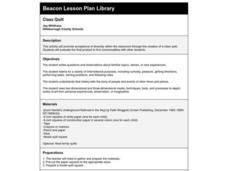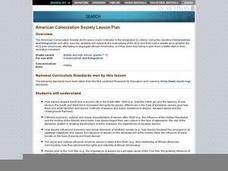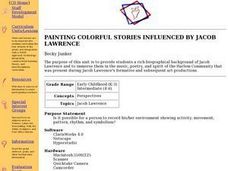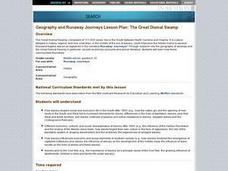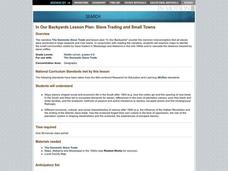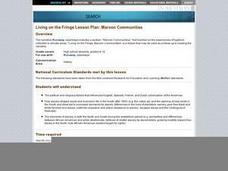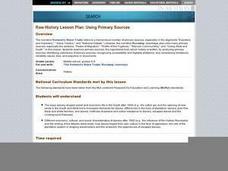Curated OER
Class Quilt
First graders engage in a instructional activity which promote acceptance of diversity within the classroom through the creation of a class quilt. They evaluate the final product to find commonalities with other students.
Curated OER
American Colonization Society Lesson Plan
Students read an article online "Colonization and Emigration" and break into debating groups. They research points that support their side, namely whether or not the American Colonization Society was for or against segregation. They...
Curated OER
Denmark Vesey's Rebellion
Students research the slave, Denmark Vesey, and create a dramatic play depicting his life.
Curated OER
Would You Stick Your Neck Out?
Students examine personal qualities of individuals who have been able to help others through selfless actions, and develop short skits about heroes who have stuck their necks out to help others.
Curated OER
Tennessee Vocabulary
In this recognizing proper nouns about the state of Tennessee learning exercise, students read the names in the word bank and match them with their descriptions. Students match 10 answers.
Curated OER
Remember the Bridge: Poems of a People
Fifth graders explore poems of African Americans. They research a famous African American, write a report, create a timeline of events in African American history, create a map of the New World, and research Molly Walsh. After...
Curated OER
Quilt Codes
Students list criteria to evaluate credible historical sources and defend their criteria in an essay. In this historical sources lesson plan, students review information of historical sources as well as the facts and pictures.
Curated OER
PAINTING COLORFUL STORIES INFLUENCED BY JACOB LAWRENCE
Students research the background of Jacob Lawrence and study the music, poetry, and spirit of the Harlem Community that was present during Jacob Lawrence's formative and subsequent art productions. They create a piece of artwork...
Curated OER
Color My World
Students examine colors and describe how colors contribute to the way a person may feel after listening to several books. Students also survey class for favorite colors and graph results, as well as discover how different colors are made...
Curated OER
Aftermath for the Freedom Seekers
Students research Black organizations the existed during the first half of the 20th Century, including the Negro Leagues baseball. They create a brochure that provides information about one of the organizations.
Curated OER
History Biographies
Students explore the life and the contributions of five people from U.S. history in the five lessons of this unit. james Madison, Dolly Madison, Sequoyah, Harriet Tubman, and Clara Barton are presented to students for exploration and...
Curated OER
THE GREAT DISMAL SWAMP
Students analyze how slavery shaped social and economic life in the South after 1800, the different economic, cultural, and social characteristics of slavery after 1800, and slavery both prior and after the Civil War.
Curated OER
SLAVE TRADING AND SMALL TOWNS
Students research the ways slavery shaped social and economic life in the South after 1800, the different economic, cultural, and social characteristics of slavery after 1800, and how the Atlantic slave trade finally ended.
Curated OER
Fugitive Slave Narratives
Students analyze the ways slavery shaped social and economic life in the South after 1800, the different economic, cultural, and social characteristics of slavery after 1800, and the ending of the Atlantic slave trade.
Curated OER
Maroon Communities
Students examine political and religious factors that influenced English, Spanish, French, and Dutch colonization of the Americas, how slavery shaped social and economic life in the South after 1800, and elements of slavery during the...
Curated OER
RAW HISTORY: USING PRIMARY SOURCES
Students analyze the ways slavery shaped social and economic life in the South after 1800, how slaves forged their own culture in the face of oppression; and the role of the plantation system in shaping slaveholders and the enslaved.
Curated OER
Whitewashing Southern History
Students discuss the fact and fiction of slavery in the South. After viewing a video on two New Orleans plantations, they determine the accuracy of the facts presented. In the computer lab, they visit various sites and examine which ones...
Curated OER
Three Coffles Lesson Plan
Students read about the slave trade in primary source documents. They discuss differences and commonalities in experiences. They write prose or poetry from the point of view of one of the figures from the reading and create a triptych.
Curated OER
Heaven, Hell, and Baltimore
This lesson allows students to research and compare the city of Baltimore to other northern cities of interest during the Great Migration. After reading a narrative entitled Return South Migration and conducting extensive research,...
Curated OER
Home Ties
Students explore the reasons people choose to migrate including political, economic and familial motivations. They interview family members and compare their ancestors own reasons for migration to those of African American urban migrants.
Curated OER
Retain or Abandon, Adapt or Convert? The Immigrant's Dilemma
Middle schoolers read and discuss a narrative exploring how immigrants retain their own cultures or assimilate into the host country. They examine the emigrant's experience in Liberia and write a position paper.
Curated OER
Molly Brown and the Titanic History Lesson
Students practice using their reading comprehension skills by reading about Molly Brown and the Titanic. They answer questions related to the reading to test for comprehension.
Curated OER
Freedom Fighters
Learners are introduced to the concept of segregation and explore its affects on society. They participate in a role-play about segregation, read books about Dr. Martin Luther King, Jr., create self-portraits, sing songs and participate...
Curated OER
Freedom Train North
Fourth graders conduct a novel study of the book Freedom Train North. They identify the parts of a story that include beginning, middle, and end. Students also recognize the setting, plot, and theme after reading a part of the book daily.


